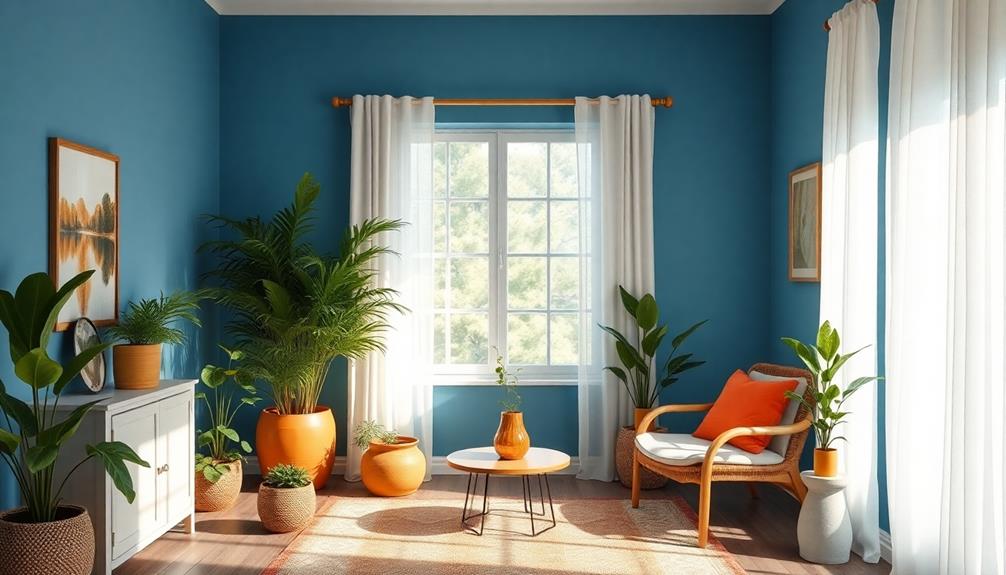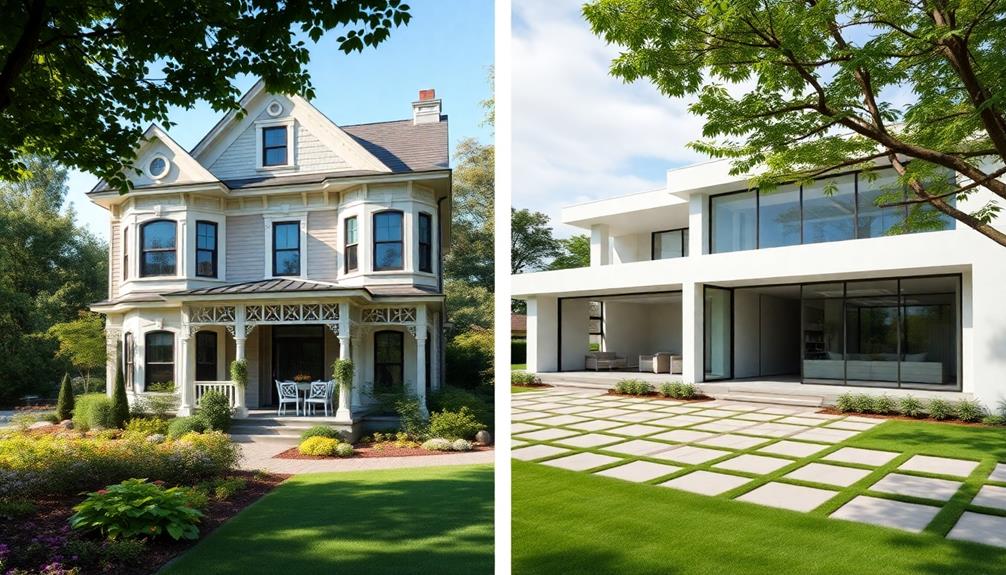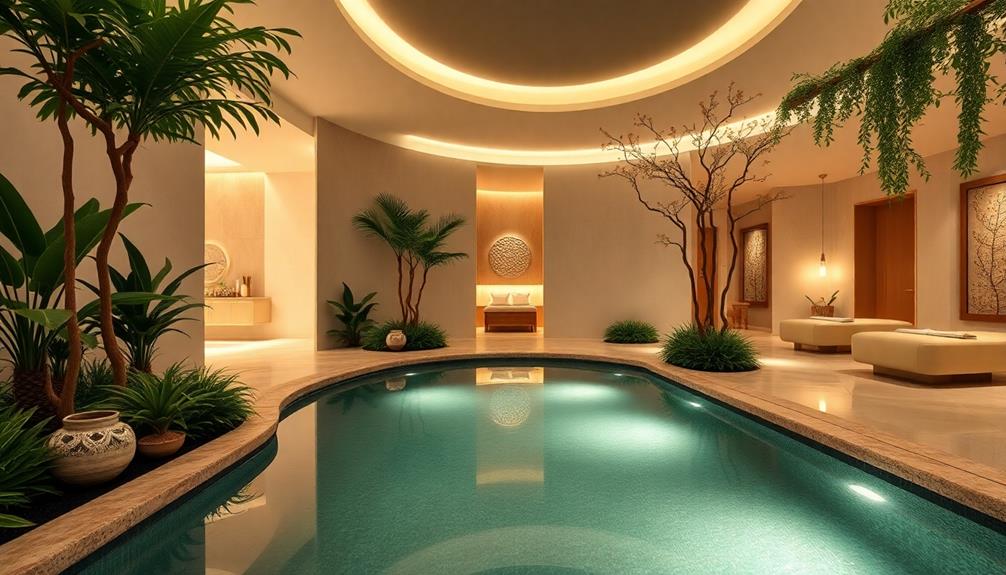Using Feng Shui color combinations can transform the energy of your space and uplift your mood. For an energizing vibe, pair warm colors like red and orange for lively areas or mix turquoise and yellow to balance joy and calm. If tranquility is your goal, soft blues and greens work wonders in bedrooms or offices. Earth tones add stability, making your environment feel secure. Don't forget to balance vibrant colors with neutrals to maintain harmony. Explore how specific colors influence different rooms and watch your space come alive in new ways.
Key Takeaways
- Combine warm colors like red and orange for an energizing atmosphere, perfect for social spaces.
- Use calming cool tones like blue and green in bedrooms to promote relaxation and tranquility.
- Mix cheerful yellow with white in kitchens to stimulate appetite and create a joyful environment.
- Balance vibrant colors with neutral tones to prevent overwhelming spaces while maintaining cohesion.
- Incorporate earth tones like beige and taupe to enhance stability and comfort in living areas.
Understanding Feng Shui Colors
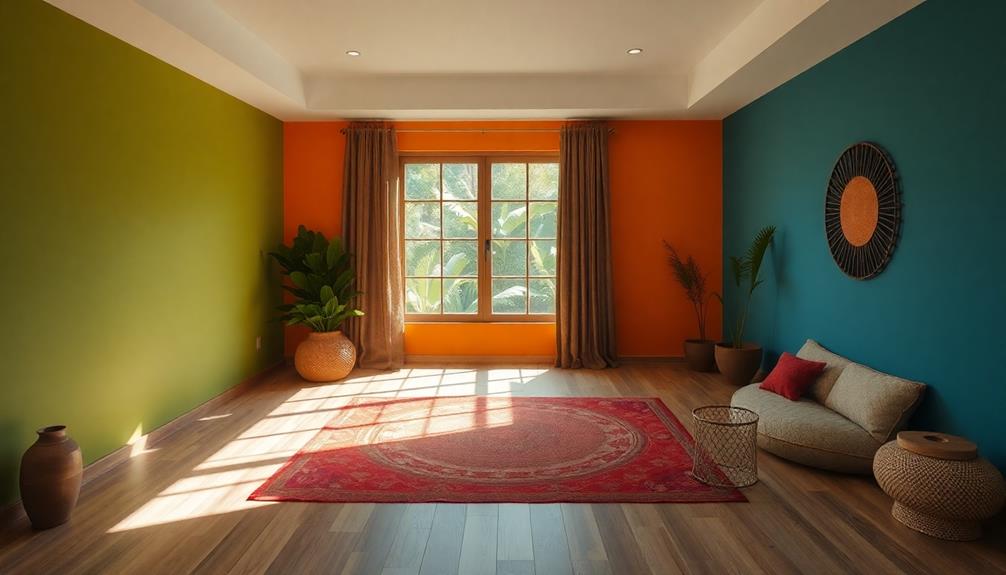
Understanding Feng Shui colors is essential for creating a harmonious living space that reflects your emotional needs and aspirations. Each color in your home corresponds to one of the five Feng Shui elements: Water, Fire, Earth, Metal, and Wood. These elements represent specific energies that influence your mood and behavior.
For example, blue and black, representing Water, evoke calmness and tranquility, while red and orange, representing Fire, stimulate energy and passion. Incorporating unique art pieces, such as a Face Indonesian Decor Mask, can also enhance the cultural significance and energy of your space.
When you choose colors according to the Shui Color Guide, you're not just decorating; you're enhancing your environment's atmosphere. Green, for instance, symbolizes growth and health, making it perfect for nurturing spaces.
By combining colors, you can alter the overall energy of a space—using earthy tones for stability or vibrant colors to inspire creativity and joy. Understanding the meanings and associations of these colors allows you to curate balanced environments tailored to your psychological needs.
Essential Color Meanings
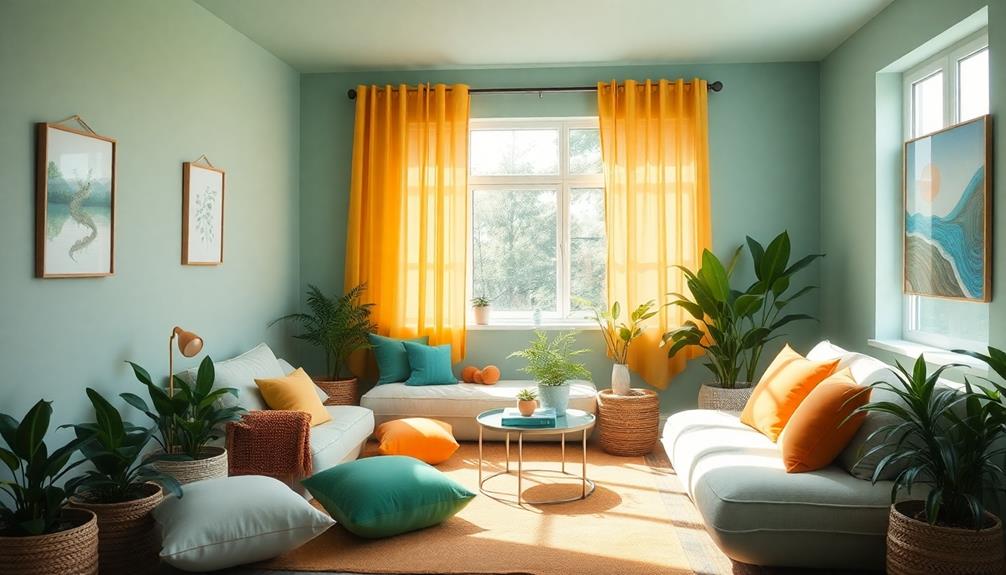
Feng Shui's color meanings play a crucial role in how you experience your living space. Each color carries specific energies related to emotions and states of being.
For instance, red ignites passion and liveliness, energizing spaces and motivating action. If you seek tranquility, blue is your go-to color, symbolizing peacefulness and wisdom—perfect for bedrooms or meditation areas.
To enhance your coastal aesthetic, consider incorporating soft blues and sandy tones, as they promote relaxation and connect you to nature coastal color palette.
Green represents health and growth, making it ideal for spaces that promote relaxation and rejuvenation, like living rooms or home offices.
When aiming to foster joy and positivity, yellow shines brightly; it stimulates appetite and conversation, so consider it for kitchens and dining rooms.
Black embodies sophistication and strength—use it as an accent to enhance grounding energy in various environments, adding depth to your design.
Energizing Color Combinations
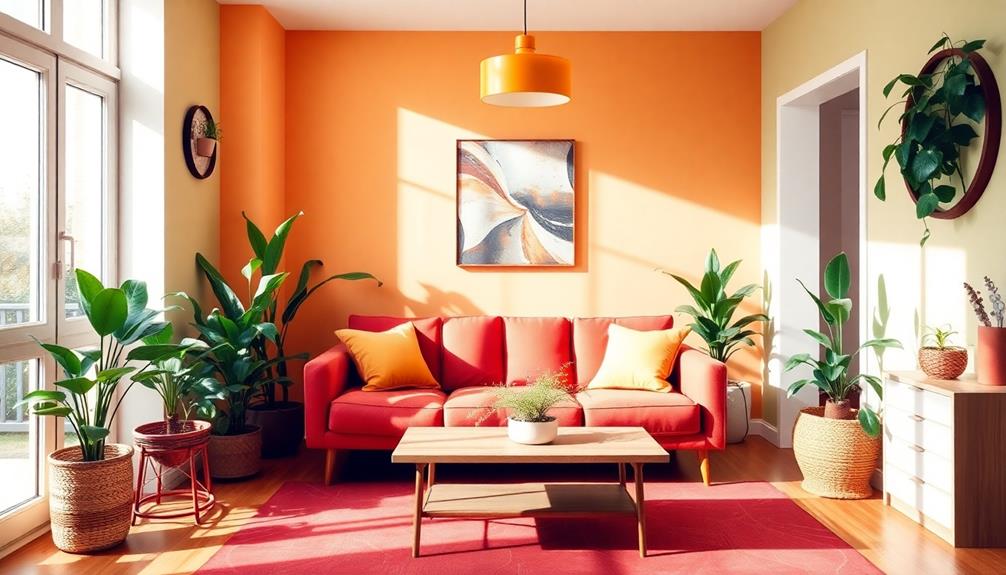
When you think about energizing color combinations, consider how dynamic pairings like red and orange can spark conversation in your living spaces.
Incorporating elements of Bohemian decor can enhance the vibrancy of these colors, as natural textures and eclectic patterns complement bold hues beautifully.
Balancing these vibrant hues effectively can transform any area into a hub of creativity and warmth.
Let's explore how these combinations can enhance the energy flow in your home.
Dynamic Color Pairings
Dynamic color pairings can truly transform a space, infusing it with energy and vibrancy. By choosing bold combinations, you can enhance the energy flow in your home.
For instance, red and orange create a fiery atmosphere that sparks conversation and creativity—perfect for lively living rooms or dining areas. Incorporating elements of Balinese design characteristics can further amplify this effect, as natural materials and motifs harmonize beautifully with vibrant colors.
If you're looking for a mix of calm and joy, turquoise and yellow would work wonders in kitchens or playrooms, promoting happiness and liveliness.
For a touch of elegance, consider pink and gold. This soft and luxurious pairing fosters a warm environment, ideal for bedrooms or living rooms where comfort is key.
Bright green and dark brown balance invigorating energy with grounding stability, making this duo suitable for home offices or study areas.
Finally, lavender and cream offer a tranquil blend that encourages relaxation, perfect for meditation spaces or serene bedrooms.
These dynamic color pairings not only elevate your space but also impact how you feel within it. Experimenting with these combinations would release your home's potential, creating an energizing atmosphere that resonates with your lifestyle.
Balancing Energies Effectively
Balancing energies in your space is essential for creating an environment that feels both vibrant and harmonious. The right colors can transform your area, enhancing mood and productivity.
Incorporating elements of Indonesian decorative pillows can further enrich the atmosphere with vibrant colors and intricate patterns. Here are some energizing color combinations to reflect upon:
- Red and Orange: These vibrant colors stimulate conversation and activity, perfect for social spaces.
- Green and Blue: This duo promotes tranquility and balance, enhancing creativity and focus in work areas.
- Yellow and Gray: Combining these colors fosters a joyful yet calming atmosphere, ideal for kitchens and dining spaces where warmth is key.
- Purple and Lavender: Mixing these shades evokes luxury while maintaining a soothing presence, great for bedrooms or relaxation zones.
Balancing Colors for Harmony
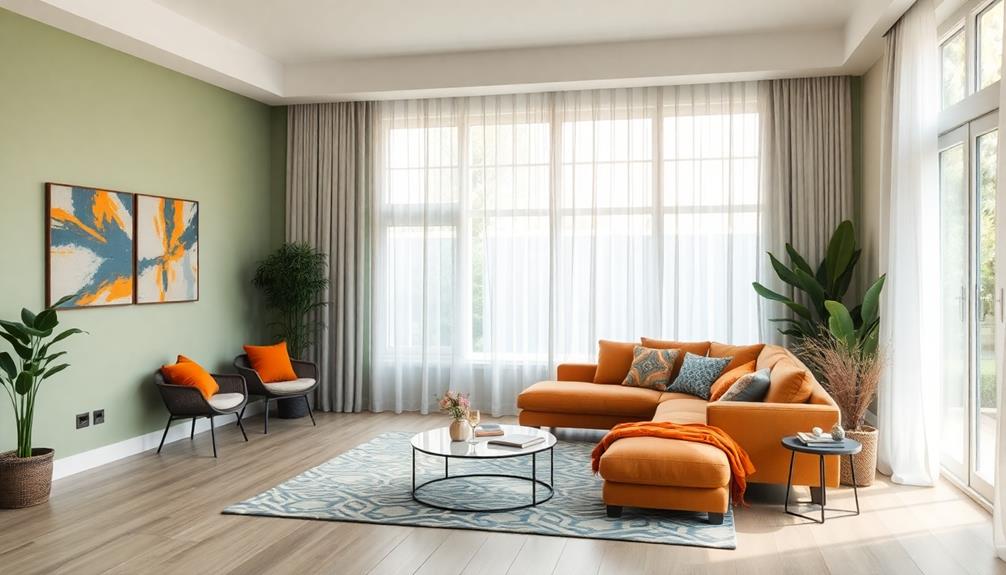
Achieving harmony in your space often involves a thoughtful blend of colors. Balancing colors is essential for creating an environment that feels both energetic and calming.
Start by mixing warm colors like red and orange with cool tones such as blue and green. This combination promotes a harmonious atmosphere, encouraging both liveliness and tranquility. To enhance this vibrant palette, consider incorporating elements of traditional Indonesian style home decor that emphasizes natural materials and intricate designs, which can further elevate the overall aesthetic.
Incorporate neutral shades like gray and white alongside vibrant hues to stabilize the overall energy. This prevents overwhelming sensations from dominating colors, ensuring your space feels inviting.
Consider using lavender, a beautiful mix of blue and purple, to evoke calmness and spirituality, perfect for relaxation and reflection.
Earth tones, like brown and beige, work well with greens to enhance feelings of grounding and security. This fosters a nurturing environment that feels safe and comforting.
Don't forget about complementary colors; pairing turquoise with coral not only boosts visual appeal but also creates a dynamic balance that encourages positive energy flow.
Impact of Colors on Mood
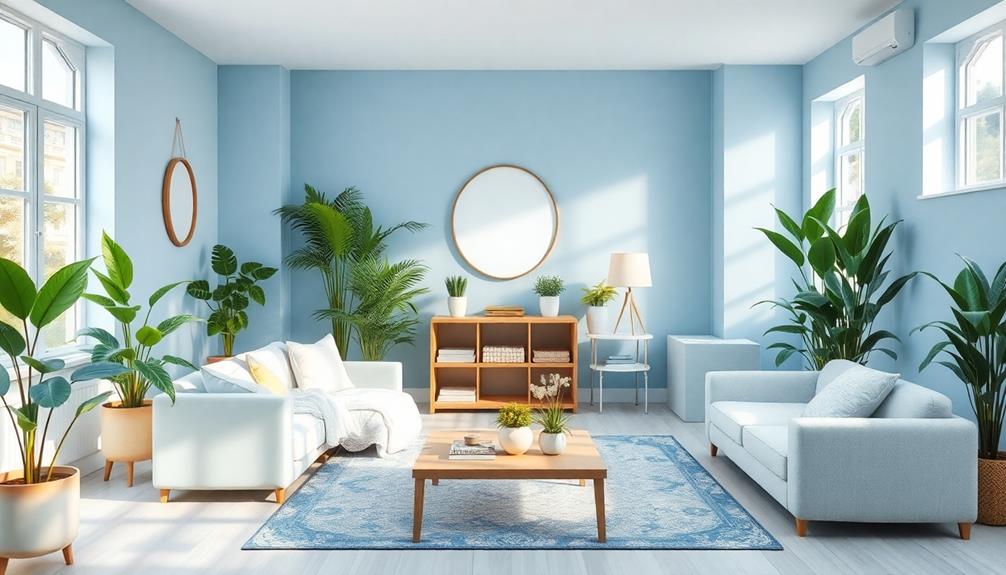
Colors play a crucial role in shaping your mood and energy. Warm colors like red and orange can energize your space, while cool colors such as blue and green help you feel calm and relaxed.
Incorporating elements of boho living room decor can enhance this effect by adding vibrant textures and patterns that stimulate the senses. Neutral shades bring balance, creating a stable environment that can ease anxiety and enhance your overall well-being.
Warm Colors Energize Spaces
Warm Colors Energize Spaces (Impact of Colors on Mood)
In social spaces like living rooms and kitchens, warm colors such as red, orange, and yellow can truly energize the atmosphere. These hues evoke feelings of excitement and enthusiasm, making them perfect for encouraging interaction and engagement.
Research shows that warm colors stimulate physiological responses, like increased heart rates, which enhance the overall energy flow in a room. Incorporating elements like adjustable lighting can further enhance the effect of these colors by creating a dynamic environment that adapts to different moods.
To harness the power of warm colors effectively, consider these four tips:
- Accent Pieces: Use throw pillows or artwork in warm hues to create inviting focal points without overwhelming the space.
- Layering Colors: Mix different warm tones to add depth and vibrancy, encouraging dynamic conversations.
- Lighting: Warm lighting can amplify the energy of these colors, making spaces feel cozier and more welcoming.
- Strategic Placement: Position warm colors in areas where you want to boost interaction, like near seating arrangements.
In Feng Shui, warm colors represent the Fire element, symbolizing passion and liveliness.
Cool Colors Promote Calmness
While warm colors energize spaces, cool colors offer a revitalizing counterbalance that promotes calmness and relaxation. If you're looking to create a peaceful environment, consider incorporating shades of blue and green into your home or workspace.
These cool colors are known to reduce stress and enhance tranquility, making them perfect for bedrooms and offices where focus is essential. Additionally, surrounding yourself with indoor plants and greenery can further amplify this calming effect by improving air quality and creating a more serene atmosphere.
Research shows that blue can lower heart rates and blood pressure, leading to heightened feelings of calmness and stability. Meanwhile, green, often linked to nature, instills a sense of renewal and rejuvenation, which can help alleviate anxiety.
By choosing soft blues and greens, you can enhance the overall ambiance of your space, fostering an atmosphere that supports mental clarity and emotional well-being.
In workspaces and study areas, these cool colors have been shown to improve concentration and creativity.
Neutral Colors Create Balance
Creating a harmonious environment often starts with neutral colors, which serve as a calming backdrop that promotes balance in any space. By using shades like beige, gray, and white, you allow other colors to shine without overwhelming the atmosphere.
This approach not only enhances mental clarity and focus but also fosters a serene setting conducive to relaxation and productivity. Incorporating elements of Scandinavian charm in kid-friendly homes can further elevate this tranquility, ensuring a safe and inviting environment for all.
Here are four powerful benefits of incorporating neutral colors into your space:
- Enhance Comfort: Neutral tones soften harsh lighting, making your environment feel more inviting.
- Reduce Stress: These colors help minimize feelings of anxiety, promoting a sense of calm.
- Versatile Style: Neutral palettes integrate seamlessly with accent colors, reflecting your personal style while maintaining stability.
- Create Tranquility: Studies indicate that neutral colors evoke feelings of peace, making them ideal for restful spaces like bedrooms and living rooms.
Color Combinations for Specific Rooms
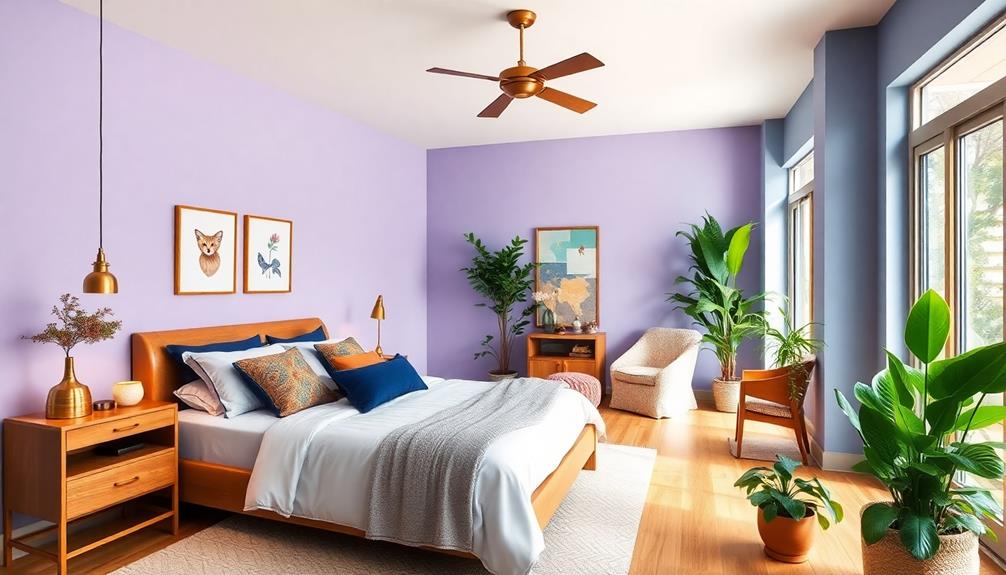
Harmony in your home can be greatly influenced by the color combinations you choose for each room. In the living room, consider using feng shui colors like bright blues and greens to attract positive energy and happiness. Adding nature-themed wallpaper can further enhance your connection to the outdoors.
For the bedroom, soft peach and pink tones foster romance and intimacy, while green linens promote vibrancy and restoration, creating a soothing environment for relaxation.
When it comes to the kitchen, opt for white cabinetry and countertops to encourage nourishment and cleanliness. Cheerful yellow accents can stimulate appetite and joy in this space, making it perfect for gatherings.
In the bathroom, soothing combinations of green, blue, and earth tones cultivate relaxation, transforming it into a personal sanctuary for self-care.
Each room serves a unique purpose, so make sure to align your color choices with that intention. By thoughtfully selecting your color combinations, you can create a harmonious atmosphere that enhances the energy of your home. Embrace the art of feng shui colors and transform your spaces into places of peace and positivity.
Feng Shui Colors for Offices
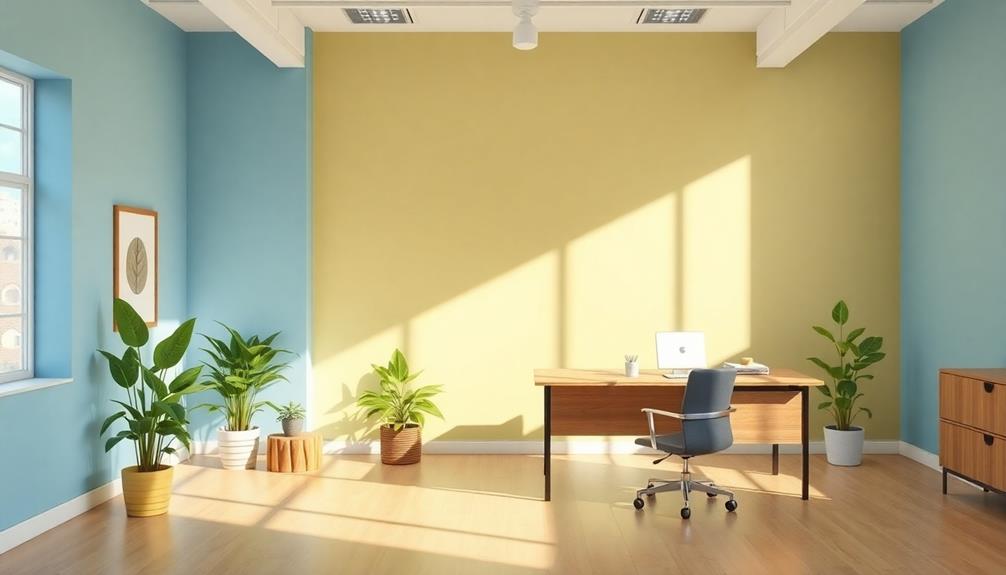
When choosing colors for your office, think about how they can impact your productivity.
Calming shades like soft blues and greens can help you focus, while earth tones create a grounding atmosphere.
Mixing in vibrant accents, like orange, can also foster collaboration and spark creativity in your workspace.
Color Effects on Productivity
Colors in your office can greatly influence your productivity and overall work experience. The right color palette can transform your home office into a space that energizes and inspires you.
Here are four color effects that can boost your productivity:
- Calming Blues and Greens: These colors stimulate creativity and enhance focus, creating a productive atmosphere.
- Whites and Pastels: Incorporating these shades can reduce stress levels and support mental clarity, keeping you sharp throughout the day.
- Earth Tones: Colors like beige and taupe foster a grounding atmosphere, reducing tension and encouraging sustained concentration.
- Green Elements: Adding plants or green hues symbolizes growth and rejuvenation, positively impacting your motivation and well-being.
Ideal Color Schemes
Transforming your office with ideal Feng Shui color schemes can considerably enhance your work environment. To create a productive atmosphere, consider incorporating calming colors like soft blues and greens. These shades promote tranquility and enhance focus, allowing you to immerse yourself in your tasks with clarity.
Earth tones, such as beige and brown, are also effective; they foster stability and comfort, helping to reduce stress during long work hours.
For moments of creativity and collaboration, adding vibrant accents like orange can stimulate energy and inspire innovative thinking. It's important to balance these bold colors with neutral tones, ensuring you don't overwhelm the space.
Additionally, opt for white and light pastel shades to reflect natural light. This creates an open and airy atmosphere that encourages mental alertness.
When selecting your color combinations, remember that harmony is key in Feng Shui. By thoughtfully merging calming and stimulating hues, you can cultivate an environment that supports both focus and creativity.
Embrace these ideal color schemes to transform your office into a space that nurtures productivity and well-being.
Choosing Colors for Front Doors
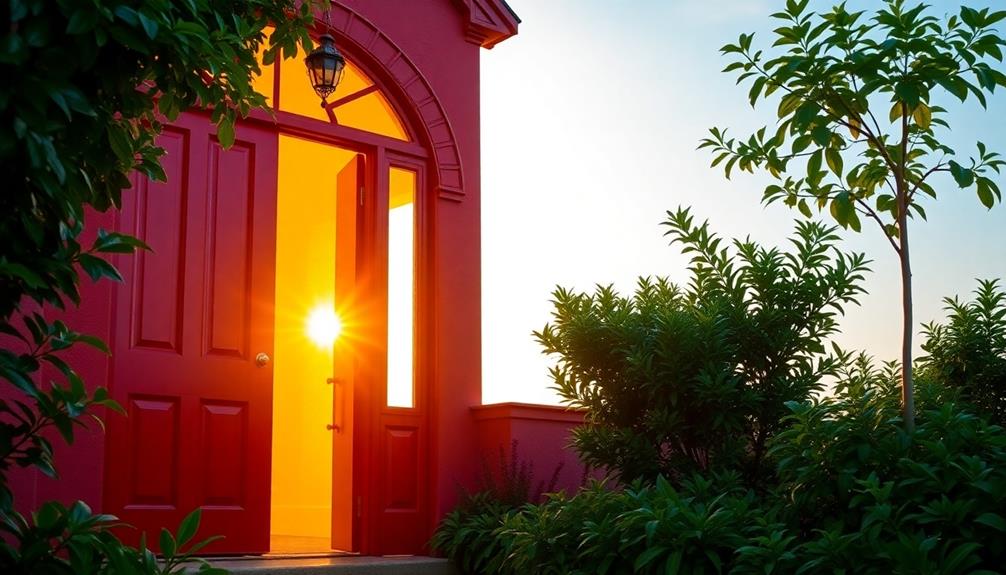
The front door is the gateway to your home, and its color sets the tone for the energy that welcomes guests. In Feng Shui, choosing the right color for your front door can enhance your home's aura. Here are some powerful options to ponder:
- Red: This vibrant hue attracts good luck and positive energy, creating an inviting atmosphere.
- Green: Symbolizing growth and harmony, a green door fosters a nurturing entryway that promotes tranquility.
- Black: Conveying sophistication and authority, a black door offers a strong presence and a sense of protection.
- Breakfast Room Green: This fresh, muted shade enhances balance and serenity, making it perfect for a calm entrance.
Each of these colors can dramatically influence the energy of your space. For instance, shades like Paen Black accentuate contrast against lighter homes, while Rectory Red exudes warmth.
You want your front door to reflect your home's personality and the welcome you wish to extend. By thoughtfully selecting a color, you can transform not just your entryway but the energy of your entire home.
Creating Calm Spaces With Color
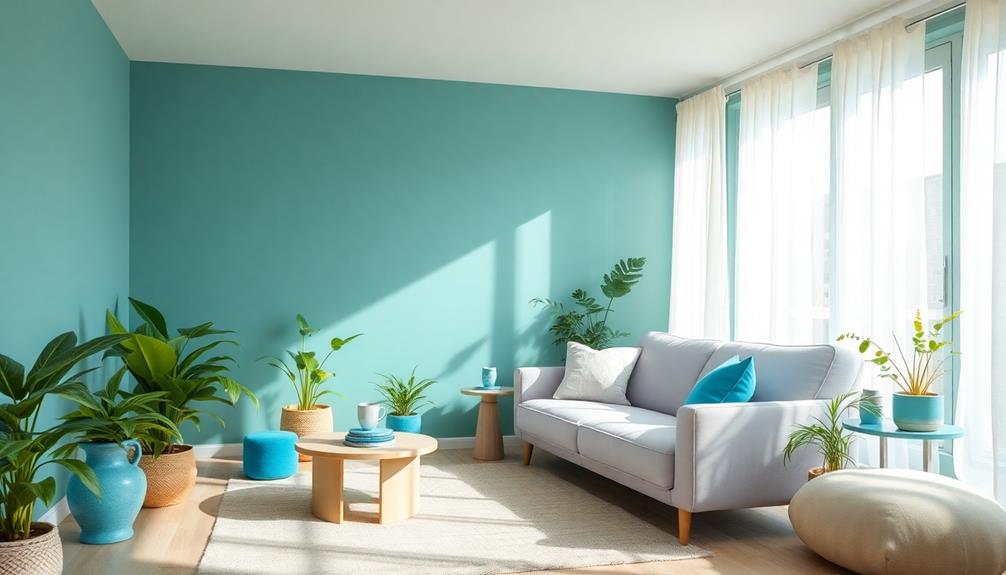
Creating a calm space in your home can greatly enhance your emotional well-being. To achieve this, focus on utilizing calming colors like soft blues and greens. These hues can markedly reduce stress and promote relaxation, making them perfect for bedrooms or any area dedicated to unwinding.
Pastel shades not only soften harsh lighting but also create a tranquil atmosphere, ideal for fostering serenity. Incorporating earthy tones, such as taupe and beige, can offer a grounding effect that enhances comfort and stability within your space.
Light colors reflect natural light, brightening your environment and contributing to a positive and uplifting vibe. This is especially beneficial in rooms where you want to cultivate a sense of peace.
Consider combining shades of blue with white to evoke a serene coastal feel. This combination works beautifully in home offices or meditation spaces, promoting clarity and tranquility.
Practical Tips for Color Selection
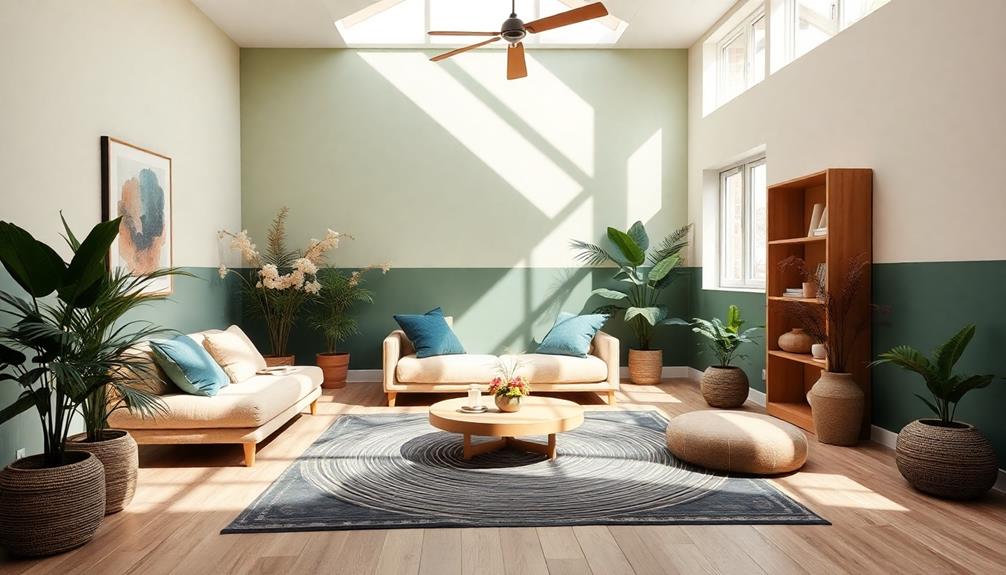
When selecting colors for your space, keep in mind the specific energies each hue can bring. Choosing the right color can transform your environment and influence your mood.
To help you in this process, consider these practical tips:
- Understand Color Meanings: Identify the color that represents the energy you want. For example, calming blues evoke tranquility, while vibrant oranges inspire creativity.
- Test in Various Lighting: Use color swatches in different lighting conditions. This way, you'll see how colors interact and impact the room's atmosphere throughout the day.
- Mix Complementary Colors: Combine hues like warm oranges with cool blues. This creates dynamic yet harmonious spaces that energize without overwhelming.
- Balance with Neutrals: Incorporate neutral tones like beige or gray to anchor vibrant colors, ensuring a cohesive and inviting design.
Frequently Asked Questions
Which Colour for Room Gives Positive Energy?
For positive energy in a room, consider using bright colors like yellow for cheerfulness, or calming shades like blue and green for tranquility. Earth tones foster comfort, while red accents can invigorate the atmosphere effectively.
What Color Creates Energy?
When you think of energy, vibrant red bursts into your mind, igniting passion and action. Bright greens breathe life into your surroundings, while sunny yellows spark joy, making any space feel alive and invigorating.
What Colors Should Be Avoided in Feng Shui?
You should avoid overly dark colors, harsh neon shades, excessive gray, clashing colors, and too many bold tones. These can create heaviness, anxiety, dullness, chaos, and confusion, disrupting the serene energy flow you desire. Instead, opt for softer, more soothing hues such as pastels, light blues, gentle greens, and warm neutrals. These serene color schemes can promote a sense of calm and relaxation, creating a more harmonious and tranquil environment. By carefully selecting your color palette, you can cultivate a space that promotes peace and positive energy.
What Are the Feng Shui Colors for Creative Space?
"You can't make an omelet without breaking eggs." In your creative space, incorporate dynamic colors like orange and red for energy, calming blues and greens for clarity, and grounding earth tones for balance.
Conclusion
Incorporating the right feng shui color combinations can transform your space like a skilled artist bringing a canvas to life. By understanding the meanings behind colors and how they interact, you can energize, balance, and create a harmonious environment that uplifts your mood. Whether it's for your office or front door, thoughtful color selection can foster a sense of calm and positivity. Embrace these insights, and watch your space flourish with vibrant energy.
